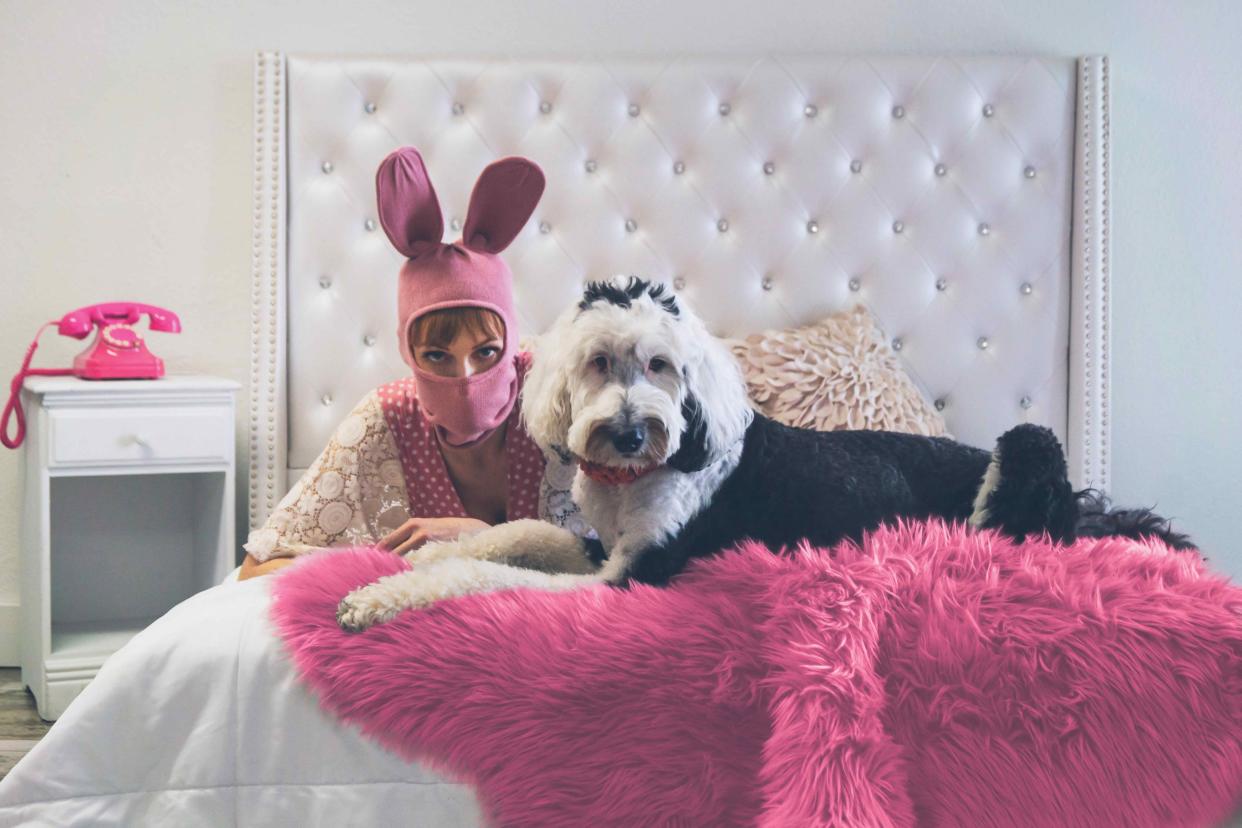Bunny the 'talking' dog's owner says the skepticism from the scientific community hurts the most

Alexis Devine went viral with Bunny, the dog she says she taught to "talk" using a soundboard.
Devine says Bunny knows 100 words — but many in the research world doubt she can really verbalize.
The pet parent told Business Insider despite the skepticism, she's grateful for their bond.
When Alexis Devine, 43, began posting videos of her sheepadoodle puppy, Bunny, in late 2019, she did not expect to go viral.
But "people liked looking at a beautiful, black and white sheepadoodle," Devine told Business Insider, adding: "It was a bright spot, and that's one of the reasons it took off."
Well, that — and the "talking."
Devine says Bunny, now 4, knows about 100 words. She said the two had conversations using recordable buttons on a soundboard known as an augmentative- and alternative communication device. Devine's new book, "I Am Bunny," chronicles the lessons she's learned from her years with the viral pooch.
It started on walks. If Bunny heard a sound that Devine could also hear, she said she'd label and narrate it. Soon, she added, Bunny was up to 10 words, then 50, then 100. Now she "almost exclusively initiates the conversation," Devine said, adding: "She will approach the buttons, wait for eye contact, and start speaking."
Aside from Bunny's viral fame — she has 1.4 million followers on Instagram and 8.4 million on TikTok — the internet-famous pooch has helped open up a new category of animal-communication research. At the University of California, San Diego, for example, the Comparative Cognition Lab is studying to what extent animals can be trained to use these "interspecies" soundboards.
Federico Rossano, the assistant professor in the Department of Cognitive Science at UC San Diego who's leading the study, told KPBS last year researchers were looking to see whether dogs could learn and understand words using symbols and sounds and then use those words in sentences. According to the university, more than 1,000 people in almost 50 countries have signed up to provide data — including Devine, who's offering up Bunny's data for the study.
But can a sheepadoodle really "talk"? While the research is ongoing, and there are plenty of detractors in other research circles, Rossano told KPBS that he believed the answer was yes.
"So, for example, Bunny, the most famous participant in our study, would say things like, 'Dog want cat down,'" Rossano told the outlet. "She's saying, 'I want the cat that is sitting up there to come down.' And she would literally push all those buttons, one after the other."
Bunny's detractors
Other animals use the buttons, too. There are cats using soundboards. There are pigs. There's not just one (Norma) but at least two cows being trained to use the devices to communicate. Some dogs in the UC San Diego study have also gone viral, including Mila, an Aussie-husky-collie mix — she's up to 36 words, according to her Instagram bio.
Devine is now a certified dog trainer but noted that she's not a scientist or speech pathologist. And as expected with internet fame, she's faced criticism and plenty of naysayers.
"Some people got angry. 'Animals can't talk,' they say. But most of it is not even worth my time," Devine said. "My perspective is you can believe what you want to believe. This is our day-to-day life. I'm not selectively editing; I'm not cherry-picking."
Jules Howard, a zoological correspondent and science writer, told the BBC in June 2022 that an animal could learn to use a soundboard because of mimicry and connection.
"Button-pressing animals could, potentially, learn to perform well at the soundboard, regardless of whether they understand that they are using human words or not," Howard wrote, adding that humans "might see more significance in the one positive button-pressing moment than the nine trials where the buttons pressed made no sense."
Some criticism of sign language studies with chimpanzees in the 1970s concluded the same — the apes didn't learn to sign. Instead, they were "prompted by his teacher's prior utterance," per a 1979 study published in Science.
A horse named Hans is perhaps the most famous example of a "talking" animal that wasn't really verbalizing. Between 1904 and '07, Hans thrilled onlookers as he tapped on numbers and letters with his hoof to answer a human's questions. But, scientists found, Hans was actually "reading the microscopic signals in the face of the questioning person" to get the answers right, per their 2013 study published in the journal Communicative & Integrative Biology.
"The criticism that hurts the most" is from the scientific community, Devine said.
How Bunny 'talks'
Devine said she never set out to join the academic discussion. When she brought Bunny home at 8 weeks old, "my goal was to have a Lassie-style relationship" with her pup, she said.
But after her experiment took off, she began to see how much deeper her relationship with Bunny could get. For instance, Devine said, one time, Bunny looked in the mirror and asked, "Who's this?" Another time, Bunny had an undetectable-to-sight paw injury, and she alerted Devine to a foxtail stuck in her paw, Devine recalled. There are videos where Bunny appears to ask for humans by name.
"We all know that dogs can learn words," Devine said. "Like walk, or outside, or treat. It's repetition paired with a stimulus."
As Bunny ages, the extra communication may help in her golden years, Devine said. Bunny struggles with chronic health issues, including quarterly episodes of gastroenteritis.
"This helped me to provide an added sense of security for her," Devine said.
Read the original article on Business Insider


